How to Bet on Hockey Online: Everything You Need to Know
While it may not yet match the massive popularity of NFL betting, hockey betting continues to grow rapidly — especially in 2025. Fans across the U.S., Canada, and around the world enjoy the fast-paced action on the ice, and the excitement only intensifies when there’s a wager on the line.
In this guide, we’ll break down how to bet on hockey, explore the different types of bets, explain key strategies and tips, and cover essential terminology to help your wagers hit the back of the net.
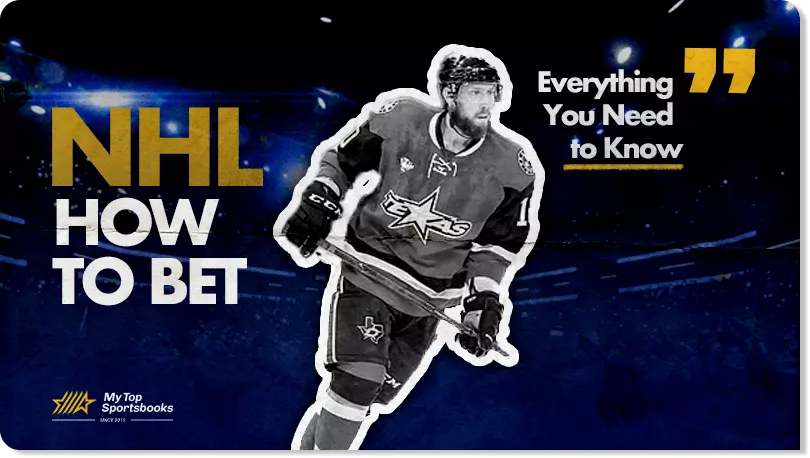
How to Bet on Hockey in 2025
Depending on your hockey knowledge, confidence level, and appetite for risk, there are various ways to bet on hockey. Whether you’re placing a futures bet, such as the Washington Capitals to take the Metropolitan Division title, or simply placing a wager on your favorite NHL team to triumph in their next game, the best hockey sportsbooks will have a wide range of bet types to suit your preferences. Many of the best bookmakers available to players will now offer access to the odds via a hockey betting app, available for iOS and Android.
Hockey Betting Explained: Hockey Betting Lines
Sometimes a straight-up bet on the moneyline will be enough, but other times you may need a more unique approach to hockey betting. The best betting sites will offer you an array of lines. Here are a few hockey betting options you will find:
- Moneyline
- Totals
- Puck Line
- 60 Minute Line
- Parlays
- Grand Salami
- Futures
- Proposition Bets
- Live Bets
Moneyline: Bet on the Winning Team
The moneyline is the simplest type of bet in hockey — and in most other sports as well. All you need to do is pick which team you think will win the game outright.
In moneyline odds, the favorite is denoted with a negative number. This indicates how much you need to bet to win $100. The underdog, shown with a positive number, represents how much you’ll win if you wager $100.
If you bet on the moneyline and the game ends in a tie, your bet ends in a push. This means you’ll get back the exact amount you wagered (you won’t make a profit, but you also won’t lose any money).
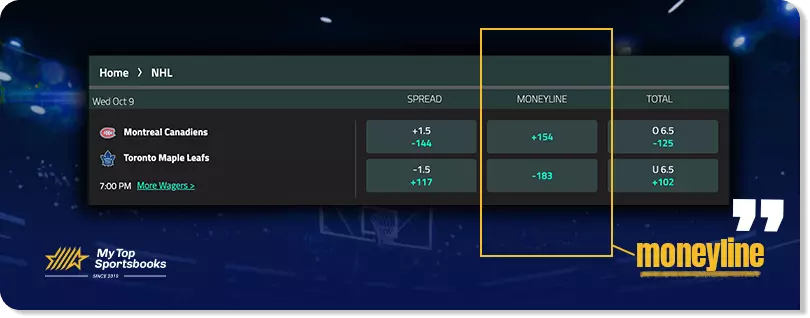
When betting on the moneyline, the closer the odds are, the less obvious the result of the game is. In these cases, betting on the underdog is less risky, but offers a lower payout. On the other hand, the more the odds are spread apart, the more obvious the result of the game is. And that’s when betting on the favorite becomes less risky, and therefore the payout is lower.
When betting on the moneyline, the closer the odds are, the more evenly matched the teams appear — making the outcome harder to predict. In these cases, betting on the underdog carries less risk but also offers a smaller payout. Conversely, the wider the gap between the odds, the more one-sided the matchup is expected to be. For example, if the Winnipeg Jets were facing the Chicago Blackhawks, the Jets would be heavy favorites in 2025. Betting on them would be considered safer, but the payout would be much lower due to the reduced risk.
A winning bet on an underdog almost always results in a big payout. However, these long shots tend to be quite risky. Seasoned hockey bettors reduce their betting risk on underdogs by selecting home underdogs with narrow point spreads.
Example: New York Rangers (+110) vs. New Jersey Devils (-130)
For example, if the New York Rangers go up against the New Jersey Devils, you will have to choose which of the two teams will come out on top. The Devils are favored in this hypothetical matchup, which is why they are denoted with negative odds (-130). The Rangers are denoted with positive odds (+110), which means they are considered the underdog in the game.
The lower a team’s odds are, the more they are favorites. So if the Devils were favorites at -200, they would have more chances to win than if they are favored at -130. The same logic applies to the underdog: the higher the odds an underdog has, the more they are considered an underdog. In this case, if the Rangers are at +110, they are less likely to lose than if they were at +200 or +300. If a team is at +300, for example, that means they probably won’t win, and the expert advice would be to avoid betting on it. If that same underdog did manage to win, however, it would give you a big payout.
Totals: Bet on the Final Score
Totals betting is a power play in the world of hockey wagering and a favorite among NHL fans. The concept is simple: the sportsbook sets a projected total number of goals for the game, and bettors choose whether the actual combined score will go over or under that number.
In NHL betting, this is commonly known as the over/under or simply “the total.” It’s a smart option when the outcome of the game feels too close to call, allowing you to focus on goal production instead of picking a winner.
Totals are typically set between 5.0 and 6.5 goals. If you bet the Over, you’re hoping for a high-scoring game; if you take the Under, you’re counting on strong defense and goaltending. For newcomers to NHL betting, leaning toward the Over is often a fun and accessible starting point.
When the final number of goals scored equals the set total — such as exactly 5 or 6 — it’s called a “push,” and your original bet is refunded. However, this rarely happens, as sportsbooks typically avoid setting whole-number totals. To eliminate the possibility of a push, bookmakers often use half-goal increments (e.g., 5.5 or 6.5). Since teams can’t score half a goal, this ensures every bet results in either a win or a loss.
You will need to consider several factors when placing a total bet, such as the goaltenders, offense, defense, matchups, and other aspects that may impact the overall result of the game. It’s a challenging yet rewarding bet type for those looking to put their hockey knowledge to the test.
Example: Montreal Canadiens vs. Pittsburgh Penguins Over 6.5 (-115) vs. Under 6.5 (-105)
Take this hypothetical match-up between the Montreal Canadiens and Pittsburgh Penguins. The total has been set at 6.5, indicating that we can expect some goal-scoring action. If you’re betting the Over, you’ll need to see at least seven goals scored in the game to win your bet. That could mean a final score of 5-4 or 6-2, for instance, as long as the total number of goals scored is 7 or more. On the flip, if you’re backing the Under, we’ll need the game to end with a total score below 7 goals. In this case, a final score of 4-0 or 5-1 would secure the win.
Futures: Bet on the Big Games
The futures markets are a staple of NHL betting. Futures allow hockey fans to place bets at any time and remain engaged with the NHL throughout the year. As the season approaches, sportsbooks open lines on a variety of NHL futures bets, ranging from the Stanley Cup winner to individual awards and team win totals.
Individual player awards are among the most popular options in the hockey futures market. To place this type of bet, you have to predict the players who will win titles like the NHL MVP, the Vezina Trophy, or the NHL Rookie of the Year. Often, sportsbooks will also offer futures bets on which hockey player will end up with more points, assists, or goals at the end of the season.
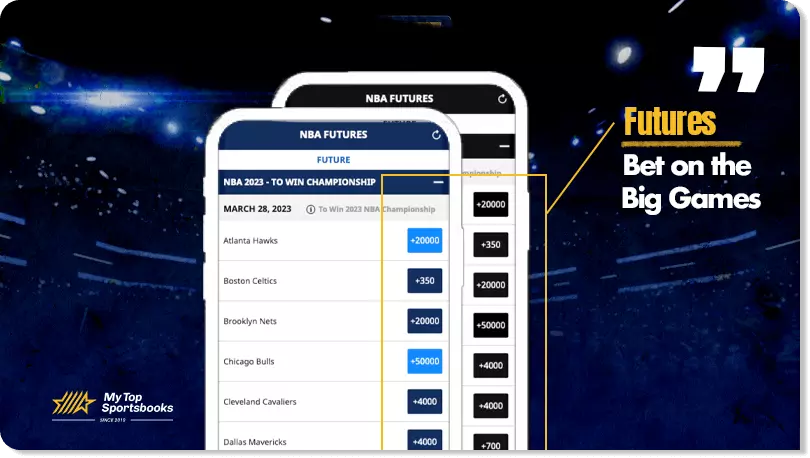
The NHL playoffs make an exceptional form of futures betting, and for good reason. Bookies offer a range of bets on the winner of individual series, as well as on the respective conferences and the Stanley Cup champion. These lines become available once the NHL playoff seeding has been determined and can offer significantly different odds than those available at the start of the season.
Example: Odds To Win NHL Stanley Cup Final
For instance, imagine you were looking to make a wager on the winner of the Stanley Cup. As of August 2025, the current favorites are Florida Panthers (+600), followed by Carolina Hurricanes and Colorado Avalanche (+800) and then Edmonton Oilers and Vegas Golden Knights (+850).
The Panthers are currently the lowest-risk bet, as they are considered the most likely team to win as of pre-season. If you fancy a long-shot, some teams have odds of more than +1000 (such as the Pittsburgh Penguins).
Puck Line Bets: Points Spread Bet
All hockey games carry a puck line betting market, as it is a popular bet type among hockey fans. Rather than choosing what team will win the game, the puck line allows you to bet on the number of points a team will win or lose by. The favorite will carry a negative number, and the underdog will carry a positive number in the puck line odds.
Bookies calculate the perceived difference between two teams factoring in a wide range of aspects, such as injured players or harsh weather conditions. Then, they strive to incentivize an equal amount of bets on both sides by allocating a puck line for the game. Put simply, the puck line is the oddsmakers’ way of balancing out favorites and underdogs–so that bets are placed in favor of both teams.
The puck line is the point spread of the game, similar to what you would see in NBA and NFL betting markets. The difference is, in hockey, the puck line is typically set at 1.5 pucks.
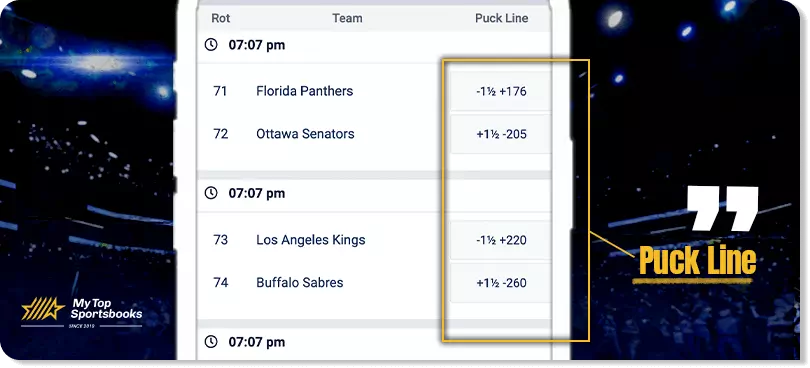
To win a puckline bet, the favorite team must win by two or more goals, while the underdog can cash in with an outright win or a one-goal loss. It’s a great option to consider when there is a clear favorite in a game, and the moneyline odds do not offer much value. By betting on the puckline, you can still back the favorite team while getting a better return on your investment.
Example: Winnipeg Jets +1.5 (-144) vs. Carolina Hurricanes -1.5 (+119)
In this example, bookies have subtracted 1.5 points from the Hurricanes’ final score, meaning they are the favorites. The Winnipeg Jets are perceived as the most probable loser for this game, and that’s why bookies have added 1.5 points to their final score. If you choose to bet for the Hurricanes, they will have to win by 2 or more points for you to receive your payout. And if you go with the Winnipeg Jets, they’d have to win outright, or loose by no more than 2 points for you to win your bet. If the Hurricanes won the game by 1 point, they would lose the puck line bet. Then the Winnipeg Jets would have lost the game but won the bet. Conversely, if the Carolina Hurricanes won the game by 6 points, they would also win the bet–and the Jets would lose both the bet and the game.
60 Minute Line: Better Odds
The 60-minute line — also known as the three-way moneyline — is similar to a standard moneyline bet but with one key difference: it only covers the first 60 minutes of regulation time and includes a third outcome — the tie.
This betting option typically offers better odds (less juice) on the favorite, but comes with added risk. If the game ends in a tie and goes to overtime or a shootout, your bet loses — even if your chosen team eventually wins. To cash in on a 60-minute line, your team must win in regulation.
If you’re confident a team will dominate early, this market can offer strong value. And if you’re looking to bet on a tie, the 60-minute line is the way to do it.
Example: Vegas Golden Knights (-130) vs. Philadelphia Flyers (+230) or Tie (+380)
In this example, the 60-minute line presents the options of Vegas Golden Night as the favorites, the Philadelphia Flyers as the underdog, and the draw. If you back the Golden Knights or the Flyers, then they must win within 60 minutes for your bet to come in. If you back the draw, then your bet comes in if the game ends with a tie after 1 hour—even if one of the teams ended up winning during overtime.
Parlays: Multiply Your Stakes
Parlay bets give you the chance to win big by placing wagers on multiple outcomes, where all of them need to occur for you to win your bet. This type of NHL betting involves multiplying the odds of each bet by our stake. You can place as few as two different bets together or even as many as the book allows! Earning a tie won’t hurt your chances of winning by much, and it won’t count toward the final payout either. That’s why, when going for a parlay bet, a tie is undoubtedly better than a loss.
Parlay bets are favored by many recreational bettors because they can lead to significantly higher payouts than single-game bets. Some sportsbooks even allow bet builders or same-game parlays, enabling bettors to add various bets such as moneyline, puckline, total, player props, and more on a single game. This type of betting strategy allows hockey bettors to create a low-risk, high-reward bet.
Grand Salami: All Night Bet
The Grand Salami is a prop bet that lets you bet on the total number of goals scored for all hockey games played in a day, typically set between 50 and 60 goals. You simply have to decide if the actual goals scored will be over or under that total. The Grand Salami is always lined with a 0.5 goal to eliminate draws. The odds can be high, so this isn’t a bet for the risk-averse. Predicting the total number of goals for all games played in a day can be complicated, but it can also be a lot of fun.
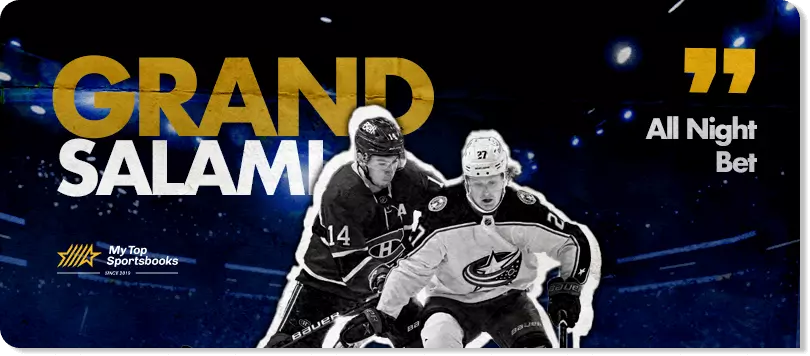
When betting on the NHL Grand Salami — a wager on the total number of goals scored across all games in a single day — goaltenders play a crucial role. If several backup or second-string goalies are expected to start, the Over becomes a more appealing option. On the other hand, if elite netminders like Igor Shesterkin of the New York Rangers or Juuse Saros of the Nashville Predators are in goal, it could indicate tighter, low-scoring matchups that support an Under bet.
It’s also smart to identify games that could skew the overall total. Look for two or three matchups where you feel confident the score will go well Over or Under. Spotting those outliers can help reduce the risk and give you a sharper edge when placing a Grand Salami bet.
Props Bets: Betting on Performance and Events
Prop bets allow you to place bets on a wide range of events within an NHL game, including but not limited to player and team performance.
These bets typically involve choosing between two outcomes, like which player will score the most goals or if the game’s total goals will be an odd or even number. Bookies typically offer three main categories of prop bets: team props, player props, and game props. Experienced hockey bettors often find prop bets appealing because they can use both their betting and NHL knowledge to predict how players and teams will perform during a game.
One of the most popular types of NHL prop bets is the player prop, which allows fans to remain engaged with their favorite hockey players and place wagers based on statistics, performance, and technique. For example, NHL goal-scoring player prop bets enable you to bet on whether a certain skater within a given game will score a goal. Usually, the odds for NHL player prop bets can vary greatly depending on the player’s profile and their opponent’s strength. Note that you may get very short odds on good snipers!
Example: Alex Ovechkin (+100) or Dylan Cozens (+225)
If you were to bet on anytime goal-scoring props in the NHL, you might come across odds like those offered for Ovechkin at +100. This means that for every $100 you wager, you stand to profit $100 if your bet wins. In the same way, a $100 bet on Cozens could potentially yield a $225 profit for a winning bettor.
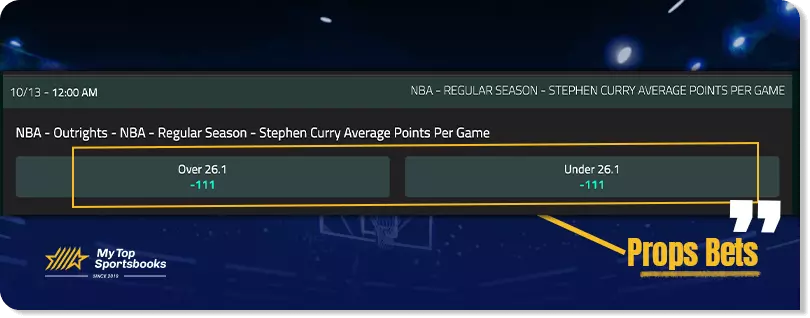
Live Bets: After the Action Starts
Live betting is an exciting option for NHL betting, as it allows you to place bets while the game is already in progress. Even the most astute pre-game predictions can be thrown off by the unpredictability of a hockey game! Live betting enables you to adjust your bets in real-time, based on the way in which the game is unfolding minute by minute.
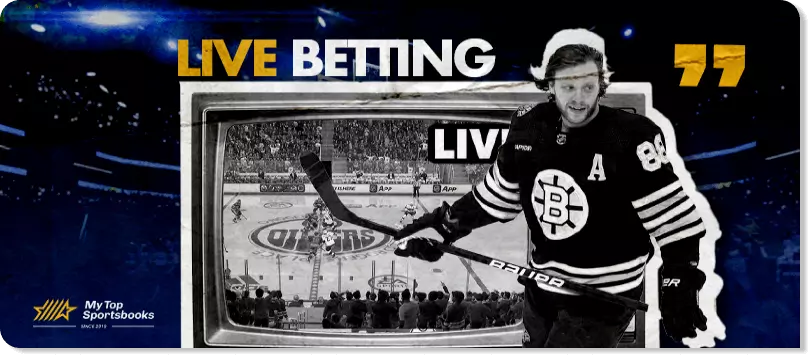
Moreover, live betting allows you to take advantage of any game developments, like a team’s persistent pressure on the opponent’s goalie, which could eventually lead to a win.
Live betting can be particularly attractive when you’re not satisfied with the pre-game odds for a certain team, as the odds can shift dramatically after the puck drops, with the favorite suddenly becoming more attainable after a tight first period!
Hockey Betting Glossary
Here are some of the main hockey betting terms:
| Hockey Betting Terms | Definition |
| Favorite | The team most likely to win |
| Underdog | The team least likely to win |
| Line Movement | The odds changing on a game |
| Cover | If a team beats the Puck Line |
| Push | If the score lands on the line and you don’t win or lose. You get your money back. |
| Juice | The sportsbook’s commission (Vig) |
| Limit | The maximum amount a sportsbook will take on a bet |
| Bad Beat | A bet that should have won but didn’t. |
| Steam | A betting line moving sharply in one direction |
| Value | Odds that represent the true value or better value than it should. |
Best Hockey Betting Tips: Hockey Betting Strategy
If you figure out which bets you want, then you will need to work out your hockey betting strategy. Check out our best hockey betting tips:
Know the Goalies
Understanding a team’s goaltending situation is essential for making accurate predictions about potential game outcomes. Since each NHL game features two goalies — one for each team — it’s important to know who’s starting. Always check injury reports, recent performance trends, and coaching strategies before placing a bet. One of the most critical stats to watch is each goaltender’s save percentage.
Experienced bettors go a step further by also analyzing backup goalies. A team with a dependable backup can present a strong betting opportunity. While a quality backup may have stats close to the starter, sportsbooks often adjust the moneyline downward when they’re in net. Interestingly, teams sometimes elevate their play when a backup starts, making it a potentially valuable angle for bettors.
Research Squad Depths
When betting on a hockey game, it’s not all about the star players. Sure, they’re important, but you need to look at the whole team and how they work together. That means paying attention to things like team strategy, player strengths, and line combinations.
Imagine you’re placing a bet on a game between the Toronto Maple Leafs and the Boston Bruins. The Bruins are known in 2025 for their exceptional depth — a well-rounded roster with skilled players on all four lines who can step up when needed. The Maple Leafs, on the other hand, boast elite talent like Auston Matthews and Mitch Marner, but they lack the same level of depth. If one of their top stars gets injured or shut down, it can be difficult for them to recover, especially against a team like Boston that thrives on balanced contributions across the lineup. This kind of roster depth can be a deciding factor when evaluating betting opportunities.
In short, always try to look at the whole roster and think about the team’s overall strength. A team with strong line combinations will usually have an edge over a team that relies too heavily on a few star players.
Read Up on Player Injuries
It’s important to keep track of player injuries and how they might impact a team’s performance. No matter how talented a player is, they can be hampered by an injury, which can make them less effective on the ice. For example, if a team’s top sniper or starting goalie is injured, it could significantly impact the game’s results, especially when playing a strong opponent.
Finding the most up-to-date information possible can be slightly tricky. Still, if a key NHL player is listed as “Out”, you can rest assured that they won’t be playing in the game. However, if they’re listed as “Questionable” or “Day-to-Day”, it can be harder to predict whether they’ll play or not. In these cases, you may want to wait until closer to game time to place your wager, as the league will probably publish more details about the player’s state.
Research the Stats
To make wise NHL predictions you need to be highly aware of the stats. Always make sure to take a good look at the previous games and how different teams fared against each other in the past. You can even take note of how teams perform in certain environments, as well as any extra motivation that a team may have against their opponent or some long-term head-to-head trends that could be in play. As they say, history has a way of repeating itself.
It’s also a good idea to notice any indicators that could point towards a team that’s ready for a regression. Check out the power play performance, shots on goal, and overtime results. These can give you a solid idea of how a team is likely to perform in their upcoming game.
Know the Schedule
Strive to know your favorite teams’ schedules like the back of your hand! Sometimes, a team’s schedule can put them under immense pressure. They may have just completed a long trip, or they may have had limited time to rest or practice.
To make the best NHL bets, find out which teams are playing on consecutive days and take note of whether they are playing at home or away. This can help you identify some factors that may prove that a team will underperform.
It’s especially key to be aware of teams traveling from the West to the East or vice versa for a game since it can alter the players’ performance.
Manage Your Bankroll
As is the case with betting on hockey, the most important thing is managing your bankroll effectively. You need to be disciplined with your bets. You need to think about making the right bets and don’t bet too big. If you have a budget, you need to manage it effectively and don’t blow it all on one ‘sure thing’. Also, avoid chasing bets and eating into extra money to do so.
How to Bet on Hockey and Win
With your tips and strategies at hand, you can now start placing the best NHL bets:
- Dive deep into the reviews: As a first step, read our reviews for different hockey betting sites to find one that suits your needs. Check the quality of their NHL odds, their range of hockey betting lines, and their reputation for security and good customer service. Also, be sure to check out the best bonuses to find a bookie that offers you the most value for your money.
- Sign up: Once you’ve found a site you like, you should open a new account. This only involves providing some basic personal information and creating a username and password.
- Make your first deposit: Next, navigate to the banking section of the site and choose the deposit option. You’ll then be able to select your preferred payment option, such as a credit card, e-wallet, or bank transfer. Keep in mind that some payment methods may have fees or processing times, you can learn more about each bookie’s deposit methods here.
- Claim your welcome bonus: After making your first deposit, you will receive a substantial bonus. These bonuses can come in many forms, such as cashback offers, free bets, or deposit matches.
- Let the fun begin: You can now start betting on NHL games! Choose the hockey game you want to bet on and select your preferred odds. You can then enter your stake and confirm your bet. Time to sit back and enjoy some thrilling NHL action!





 Best Offshore Sportsbooks
Best Offshore Sportsbooks